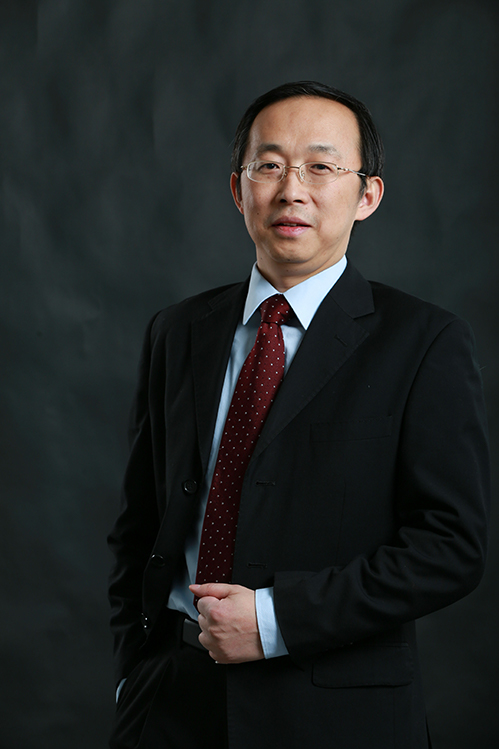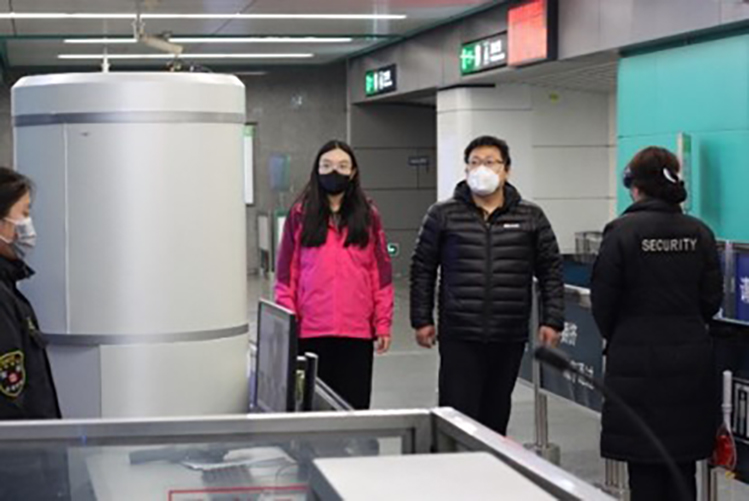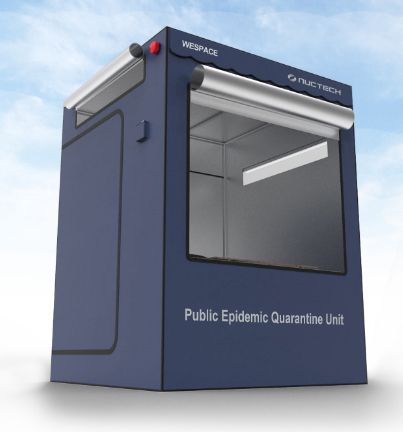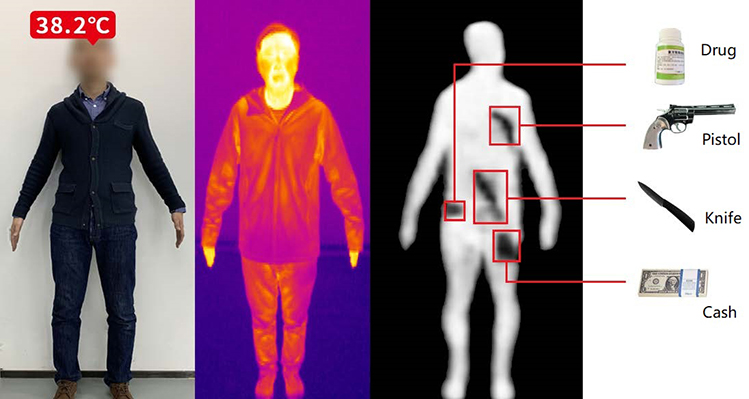The global COVID-19 pandemic continues to spread at an alarming rate, causing great harm to the world economy and global aviation industry. Serving at the forefront of people flow, both airlines and airports serve as the gatekeeper to fight against the possible spread of the virus. To ensure safe travel for the general public, they are striving to help identify and take care of infected travellers, protecting and facilitating the healthy flow of passengers.

Prof. Zhiqiang Chen from Tsinghua University, Chairman, President and Chief Executive Officer, NUCTECH: “As the pandemic is ravaging the world, COVID-19 may change our perception of security once and for all. It is envisaged that airports might be tasked to guide against not only the explosives, but also the equally devastating health risk.”
“As the pandemic is ravaging the world, COVID-19 may change our perception of security once and for all,” says Prof. Zhiqiang Chen from Tsinghua University, Chairman, President and Chief Executive Officer, NUCTECH. “It is envisaged that airports might be tasked to guide against not only the explosives, but also the equally devastating health risk.”
Some experts believe that we are likely to live with the health testing, such as temperature checks, well after the pandemic is over, just as the liquids ban still exists post the foiled liquid explosive attack in 2006.
Protect by detection
The World Health Organization claims that exported cases of coronavirus were “detected through entry screening” and added that the spread of the disease could be reduced if temperature screening was used. Indeed, airports in Thailand, China and Mexico are starting to use thermal scanners on incoming passengers. Against this backdrop, NUCTECH has integrated its proprietary thermal imaging camera into its Terahertz body scanner to launch a one-stop solution for real-time people screening, helping airports, airlines and other aviation authorities to safeguard the travellers and protect their staff.
“By using the integrated solution, our Terahertz body scanner can precisely alert passengers with elevated body temperatures within 2.5 metres, assuring a smooth and non-intrusive screening for suspect patients,” Prof. Chen explains. “With no close contact needed during the process, it serves well to protect the staff by allowing them to be situated away from the passenger flow, observing social distancing while on duty. If people with abnormal temperatures are found, an alarm would be automatically triggered, and the operators are immediately notified to take on further actions, whether it be some additional check-ups of temperatures, or further inquiries of their travel or contact history.”
Located in the passage or entrance of the terminal, the integrated solution allows for an extra layer of security and safety at the airport. Finding the suspect patients early on, before they reach out to the bigger crowd at the checkpoint, can significantly decrease the risks of virus transmission.
Equipped with deep learning algorithms, the integrated solution can adapt quickly to different settings, minimise background distractions, and detect faces accurately. It also detects the body temperature of people standing still or moving around with high precision.
“The integrated solution boasts a throughput of over 2,000 persons per hour to accommodate a high footfall scenario by allowing multiple people to be screened simultaneously,” says Prof. Chen. “It eliminates the need for line-ups at temperature checkpoints, curbing the spread of any possible virus through congregation.”
To accommodate myriad scenarios, the thermal imaging module can also be integrated with a variety of NUCTECH scanners to implement a more thorough security and safety check for the travellers. “Combined with our metal detector portals, passengers can be checked for elevated body temperatures alongside any concealment of sharps or weapons, allowing for a safe, smooth and reliable screening experience,” Prof. Chen comments.

NUCTECH has integrated its proprietary thermal imaging camera into its Terahertz body scanner to launch a one-stop solution for real-time people screening, helping airports, airlines and other aviation authorities to safeguard the travellers and protect their staff.
Respond by isolation
When passengers with high temperature are detected through the integrated solution, the airport needs temporary quarantine room for those suspect patients before medical care arrives. During the waiting period, the airport is obligated to protect its staff and the general public from contracting the virus, so a quarantine area is required to isolate the patients for further medical treatment.
To help airports prepare for this situation, NUCTECH has developed a proprietary convertible quarantine room to separate suspect patients from the general public and cut off the transmission of any virus. “The walls of the chamber are made of a unique composite material to allow for a sterile environment,” says Prof. Chen. “Further equipped with an Ultra Violet module, it can be activated to disinfect the chamber thoroughly after the patient has been transferred. With the self-sterilization module in place, the quarantine room can be reused safely.”

NUCTECH has developed a proprietary convertible quarantine room to separate suspect patients from the general public and cut off the transmission of any virus.
Combined with data processing technology, the quarantine room also enables non-contact investigation of the passenger’s identity, travel history or possible connection with confirmed cases, etc. “With the two-way intercom system integrated, the quarantine room can better support airport staff to do their job without risking their own lives to be exposed to dangers,” Prof. Chen explains. “By adopting a modular design, the compact quarantine room is easy to set up or relocate to other hotspots around the airport, addressing ever-changing needs from different locations. Experienced staff can complete the installation within half an hour. Just basic training would be sufficient to make it work.”
Non-contact journey
The impact of COVID-19 on aviation is potentially huge and longstanding. Even after the crisis, we might see the travel experience quite different from what existed before. “Security might be redefined as something more than a freedom from dangerous items, but a more comprehensive notion encompassing physical and pathological dimensions,” says Prof. Chen. “To cope with this new trend, airports and industry need to collaborate hand-in-hand to get our aviation sector fully prepared for the post-COVID-19 era.”
In addition to the widespread temperature checks, the future travel experience might also include contact-free processing to avoid transmission of any virus or bacteria in the airport. Prof. Chen explains that more high-tech solutions could be introduced to the passenger journey, including automatic self-check-in, self-bag drop or paperless identity authentication. “As for the security checkpoint, promising technologies would also be more widely adopted to minimise unnecessary physical contact, without compromising security.” These may include:
- “Checkpoint CT scanners, allowing passengers to keep liquids and laptops in their bags. Much fewer trays would be required, reducing the possibility of infection via physical touch.”
- “Automated tray return systems free staff from the troublesome and now dangerous tray moving.”
- “Checkpoint CT scanners and next-generation body scanners, reducing the need for pat downs or physical searches, and minimising close contact between passengers and officials.”
- “Remote screening, allowing for social distancing by enabling the screener to be situated in a separate location away from the hustle and bustle of the checkpoint, as well as the possible transmission of any dangerous viruses. It can effectively protect its workforce from the health risk while at the same time ensuring the efficiency of the security check.”

“By using the integrated solution, our Terahertz body scanner can precisely alert passengers with elevated body temperatures within 2.5 metres, assuring a smooth and non-intrusive screening for suspect patients,” says Prof. Zhiqiang Chen from Tsinghua University, Chairman, President and Chief Executive Officer, NUCTECH.







